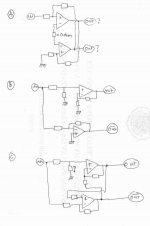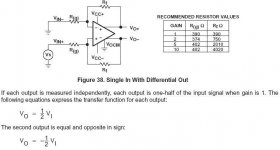What is the best possible unbalance-balance converter using opamp? In RodE's site he's using a cross feedback between 2 opamps (like C). Is this giving better performance than stand alone (B)?
I saw (A) in here. Is (A) possible to make unbalance-balance converter?
Maybe I draw (C) wrongly. RodE using 3 opamp. I saw these kind of configuration with 2 opamps, in PDF somewhere in here, but forgot how it looks like, feedback crossing with only 2 opamps. Anyone can help, which opamp pdf datasheet have drawings like (C)?
I saw (A) in here. Is (A) possible to make unbalance-balance converter?
Maybe I draw (C) wrongly. RodE using 3 opamp. I saw these kind of configuration with 2 opamps, in PDF somewhere in here, but forgot how it looks like, feedback crossing with only 2 opamps. Anyone can help, which opamp pdf datasheet have drawings like (C)?
Attachments
A has positive feedback, so i'd say not to use it.
B has a lot of resistors. they must be chosen such that the resistors on the bottom opamp are 2x the resistors on the top.
C doens't look like it works.
B has a lot of resistors. they must be chosen such that the resistors on the bottom opamp are 2x the resistors on the top.
C doens't look like it works.
Member
Joined 2002
What about just useing a balanced chip ? I ordered a few samples they go from rca to balanced and there pretty cheap.
Look at Texas Instrument home page and search Burr-Brown's OPA1632.
The OPA1632 is a fully-differential amplifier from input stage to output stage. It is dedicated to driving high-performance ADCs.
FEATURES:
Distortion: 0.000022%, Noise: 1.3nV/SQRT Hz, SR: 50V/µs, GBW: 180MHz
Supply: ±2.5V to ±16V, Power Shutdown option.
The OPA1632 is available in an SO-8 package and a MSOP-8 PowerPAD package.
The OPA1632 is a fully-differential amplifier from input stage to output stage. It is dedicated to driving high-performance ADCs.
FEATURES:
Distortion: 0.000022%, Noise: 1.3nV/SQRT Hz, SR: 50V/µs, GBW: 180MHz
Supply: ±2.5V to ±16V, Power Shutdown option.
The OPA1632 is available in an SO-8 package and a MSOP-8 PowerPAD package.
To the unwashed, the 1632 circuit looks similar to the 135 circuit, but close examination shows that it is not.
If you actually intend to send audio any distance down a balanced line, the circuit must mimic a transformer.
If you actually intend to receive audio any distance down a balanced line, the receiver must be a transformer. The receiver chips, despite their 0.001% matching of resistors, are up to 50dB worse than a transformer.
Those that have been to the balanced line seminar at CEDIA will be familiar with these ideas.
If you actually intend to send audio any distance down a balanced line, the circuit must mimic a transformer.
If you actually intend to receive audio any distance down a balanced line, the receiver must be a transformer. The receiver chips, despite their 0.001% matching of resistors, are up to 50dB worse than a transformer.
Those that have been to the balanced line seminar at CEDIA will be familiar with these ideas.
Take a look at these http://www.analog.com/Analog_Root/productPage/productHome/0,,SSM2142,00.html
They work really well in everything I've used them for. Low noise and the ability to drive very long cables. Its an easy one chip solution.
They work really well in everything I've used them for. Low noise and the ability to drive very long cables. Its an easy one chip solution.
While the SSM2142 mimics the performance of fully balanced
transformer-based solution for line driving, the previously linked to TI/BB DRV135 is an IMPROVED REPLACEMENT FOR SSM2142.
The SSM2142/2141 is the SPECIFIC CHIP SET used in the CEDIA seminar showing that this solution can be up to 50dB worse than using a transformer for the receiver.
transformer-based solution for line driving, the previously linked to TI/BB DRV135 is an IMPROVED REPLACEMENT FOR SSM2142.
The SSM2142/2141 is the SPECIFIC CHIP SET used in the CEDIA seminar showing that this solution can be up to 50dB worse than using a transformer for the receiver.
Member
Joined 2002
"Making discrete opamp for design like DRV134 block schematic is good? I cannot buy DRV134 here."
See if the SSM2142 is available in your area, if not then sure, just use three good opamps. The gain resistors need to be selected to 0.1% (or better) starting from 1% resistors.
Depending on on the opamp you use, the 50 ohm resistors on the output may need to be increased to 100R~300R (matched of course). Don't forget the cross-coupling of the feedback/current sense lines, that's what makes this circuit work better than the OPA1632.
See if the SSM2142 is available in your area, if not then sure, just use three good opamps. The gain resistors need to be selected to 0.1% (or better) starting from 1% resistors.
Depending on on the opamp you use, the 50 ohm resistors on the output may need to be increased to 100R~300R (matched of course). Don't forget the cross-coupling of the feedback/current sense lines, that's what makes this circuit work better than the OPA1632.
In Nelson Pass's article about SuSy, in the front page he mentioned a little about bridged configuration. I'm not sure wheter what he is talking about is like DRV134, but he said that feedback that is cross coupled from each output will add distortion, because each opamp will amplify other opamps distortion. Or DRV134 block schematic do exactly the opposite, canceling each other's distortion by cross coupling?
"Or DRV134 block schematic do exactly the opposite, canceling each other's distortion by cross coupling?"
Who cares?
In general people are obsessed with specs.
At the risk of repeating myself, the cross coupling is to allow us to mimic a transformer.
In the real world a transformer works much better, but they are expensive, and large.
99% of the benefits of a transformer system may be had by using a cross coupled driver circuit with a transformer as the receiver.
If you need a tutorial on why transformers work better, try the Rowland site and Jensen.
Who cares?
In general people are obsessed with specs.
At the risk of repeating myself, the cross coupling is to allow us to mimic a transformer.
In the real world a transformer works much better, but they are expensive, and large.
99% of the benefits of a transformer system may be had by using a cross coupled driver circuit with a transformer as the receiver.
If you need a tutorial on why transformers work better, try the Rowland site and Jensen.
- Status
- Not open for further replies.
- Home
- Amplifiers
- Solid State
- unbal-balanced driver with opamp

